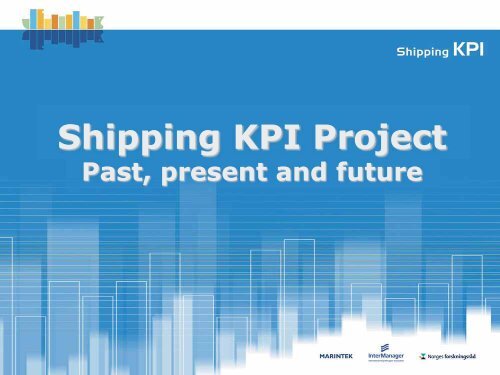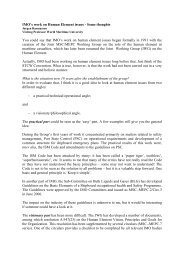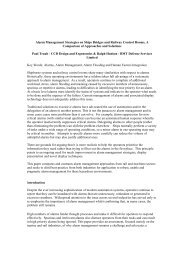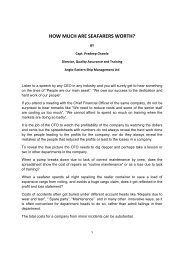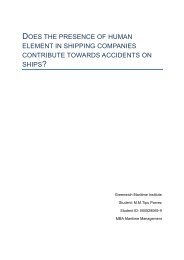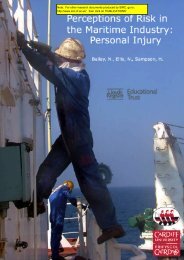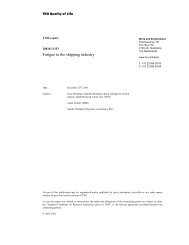Shipping KPI Project
Shipping KPI Project - Alert!
Shipping KPI Project - Alert!
- No tags were found...
You also want an ePaper? Increase the reach of your titles
YUMPU automatically turns print PDFs into web optimized ePapers that Google loves.
<strong>Shipping</strong> <strong>KPI</strong> <strong>Project</strong><br />
Past, present and future
Today's topic<br />
• <strong>Shipping</strong> <strong>KPI</strong> <strong>Project</strong> Goals<br />
• <strong>Shipping</strong> <strong>KPI</strong> <strong>Project</strong> Methodology<br />
• <strong>Shipping</strong> <strong>KPI</strong> <strong>Project</strong> Achievements
Current industry situation<br />
• Too many different indicators (<strong>KPI</strong>s)<br />
• Comparison of performance between companies is difficult<br />
due to lack of standardization<br />
• Difficult to mobilize organizational focus on quality<br />
improvement<br />
• Additional manpower required to present the same<br />
information in many different ways<br />
(onboard, in office and to externals)<br />
• Emerging new reporting requirements<br />
(On environmental performance & Corporate Social Responsibility (CSR))
The <strong>KPI</strong> <strong>Project</strong> objectives<br />
Develop tools to measure company and vessel performance<br />
and get these recognized as “the Standard of the Industry”<br />
In order to:<br />
• boost performance improvements internally<br />
• provide an efficient communication platform about ship<br />
operation performance information to internal and external<br />
stakeholders through increased transparency
The project<br />
Norwegian Research Council<br />
<strong>Project</strong> Responsible<br />
Wilh. Wilhelmsen ASA<br />
<strong>Project</strong> Partner<br />
MARINTEK<br />
<strong>Project</strong> Partner<br />
InterManager<br />
Stakeholders<br />
<strong>Shipping</strong><br />
Companies<br />
<strong>Shipping</strong><br />
Companies<br />
<strong>Shipping</strong><br />
Companies<br />
<strong>Shipping</strong><br />
Companies<br />
InterManager members<br />
Trade Organisation<br />
Regulators e.g. IMO<br />
EU DG-TREN<br />
Labour Organisations<br />
Insurance<br />
and many more
<strong>Shipping</strong> <strong>KPI</strong> Phase 1 & 2 - Content<br />
2006-2008 2009-2011<br />
<strong>Shipping</strong> <strong>KPI</strong> Phase 1<br />
<strong>Shipping</strong> <strong>KPI</strong> Phase 2<br />
<strong>KPI</strong> definitions<br />
Validation of <strong>Shipping</strong><br />
<strong>KPI</strong> Standard<br />
Increased transparency<br />
of performance<br />
to external stakeholders<br />
Aggregation principles<br />
and SPI definitions<br />
Develop<br />
communication models<br />
for performance<br />
information<br />
Internal improvements<br />
and performance<br />
management processes<br />
<strong>KPI</strong> depository and<br />
awareness in<br />
industry<br />
Develop tools for<br />
benchmarking<br />
Developments<br />
towards “process output”<br />
regulations
<strong>Shipping</strong> <strong>KPI</strong> Phase 2 WG Participants<br />
Bernhard Schulte<br />
Shipmanagement<br />
Bill Lunn<br />
Group Director - Loss prevention,<br />
safety & quality<br />
Columbia Shipmanagement Dietrich Wulff Q.A. Manager<br />
ConsultISM David McFarlane <strong>Project</strong> Manager<br />
EMS Ship Management Ranjith Cheerath Marine, Safety & Quality Director<br />
Epic Asia Sanjay Mittal Assistant General Manager, DPA<br />
Epic Europe/Meridian Marine David Turner Manager Risk, Safety and Security<br />
Hoegh Fleet Services Alv Johan Erikstad Controller, Fleet Management<br />
Maersk Ship Management Terry Cornick Managing Director<br />
Marfin Management S.A.M. Alexandre Albertini Director<br />
NovoShip Alexey O. Khaydukov Quality Assurance Director<br />
NYK Shipmanagement<br />
Singapore<br />
Hemant Pathania<br />
Managing Director & COO<br />
Seaspan Ship Management Peter Curtis Vice President<br />
Thome Ship Management<br />
Singapore<br />
Bjorn Hojgaard<br />
Managing Director<br />
V.Group Simon Pressly Chief Information Officer<br />
Wilhelmsen Ship Management John-Christen Jensen Vice President Shipmanagement<br />
NewsLink George Hoyt Founder<br />
Tsakos <strong>Shipping</strong> Hellas A. Rozakis General Manager<br />
Interorient Steve Hardy Manager HSEQ<br />
MMS Japan T. Ajay Managing Director
Requirements for <strong>Shipping</strong> <strong>KPI</strong>s<br />
• <strong>KPI</strong> accepted as part of the <strong>Shipping</strong> <strong>KPI</strong> performance hierarchy<br />
must be:<br />
– Observable and quantifiable<br />
Mathematical formula on basis of unambiguous, observable measurements<br />
– Valid indicator of performance<br />
Express performance within an area which the Ship Manager needs to perform well as<br />
well as having complete control of the factors affecting the performance<br />
– Robust against manipulation<br />
To a large extent related to unambiguous descriptions of the needed measurements<br />
No room for “favourable interpretations”<br />
– Sensitive to change<br />
Will actual changes in the Ship Manager’s performance be reflected well (by<br />
increase/decrease) in the <strong>KPI</strong> Value over time?<br />
– Transparent and easy to understand<br />
Would all of the “users” of the <strong>KPI</strong> interpret the <strong>KPI</strong> in the same manner<br />
<br />
If the <strong>KPI</strong> can be said to be context-dependent, a high <strong>KPI</strong> Rating for one Ship Manager is not<br />
necessarily a positive thing while for another Ship Manager a high <strong>KPI</strong> Rating on the same <strong>KPI</strong><br />
is to be interpreted as very positive indeed<br />
– Compatible<br />
Is the <strong>KPI</strong> harmonized with the rest of the performance hierarchy?<br />
The <strong>KPI</strong> must be compatible with other <strong>KPI</strong>s to prevent the decision-makers receiving<br />
contradictory control signals
The <strong>Shipping</strong> <strong>KPI</strong> Standard - Concept<br />
SPI<br />
Aggregated indexes for external<br />
communication<br />
Financial<br />
Processes<br />
<strong>KPI</strong><br />
Customer<br />
Learning<br />
PI<br />
HSE<br />
Others<br />
Extended Balanced Score<br />
Card for internal<br />
improvement<br />
Corporate<br />
measurements
The Concept of the <strong>Shipping</strong> <strong>KPI</strong> Standard<br />
SPI – mathematical definitions (linear calculation<br />
using weighted sum of <strong>KPI</strong> Ratings)<br />
<strong>KPI</strong> – mathematical definitions based on the PI<br />
Values. Two concepts are defined<br />
Financial<br />
Processes<br />
Customer<br />
SPI<br />
<strong>KPI</strong><br />
Learning<br />
HSE<br />
Others<br />
The <strong>KPI</strong> Value (natural number calculated<br />
directly from PI Values)<br />
The <strong>KPI</strong> Rating bringing the <strong>KPI</strong> Value into<br />
a 0-100 range)<br />
PI<br />
PI –<br />
textual definitions of measurements (PI<br />
Values) and guidelines for data collection
The <strong>Shipping</strong> <strong>KPI</strong> Standard - SPIs<br />
• Environmental performance<br />
• HR performance<br />
• Safety performance<br />
• Security performance<br />
• Technical Performance<br />
• Navigation Performance<br />
• Operational Performance
<strong>Shipping</strong> <strong>KPI</strong>s in the BSC perspectives<br />
PROCESS (internal)<br />
Cargo damage ratio<br />
Condition of class<br />
Drydocking planning performance<br />
Environmental deficiencies<br />
Failure of critical equipment and systems<br />
Flawless port state control performance<br />
HR deficiencies<br />
Navigational deficiencies<br />
Navigational Incidents<br />
Operational cargo incidents<br />
Operational deficiencies<br />
Port state control deficiency ratio<br />
Port state control detention<br />
Safety deficiencies<br />
Security deficiencies<br />
CUSTOMER (customer)<br />
Budget performance<br />
Vessel availability<br />
HR (innovation and learning)<br />
Crew disciplinary frequency<br />
Crew planning<br />
Officers experience rate<br />
Officer retention rate<br />
Training days per officer<br />
Cadets per vessel<br />
HSE (new)<br />
Accidental releases of substances as def by MARPOL<br />
Ballast water discharge violations<br />
CO2 efficiency<br />
Contained spills<br />
Fire and Explosions<br />
Lost Time Injury Frequency<br />
Lost Time Sickness Frequency<br />
No of violations of MARPOL Annex 1-6<br />
NOx efficiency<br />
Passenger injury ratio<br />
SOx efficiency<br />
(text in italic refer to Kaplan Norton perspectives, HARVARD BUSINESS REVIEW Jan-Feb -92)<br />
For an updated list of <strong>KPI</strong>s please visit www.shipping-kpi.com
The <strong>Shipping</strong> <strong>KPI</strong> Standard - PIs<br />
Actual drydocking costs<br />
Actual drydocking duration<br />
Actual off-hire<br />
Agreed drydocking costs<br />
Agreed drydocking duration<br />
Average number of officers employed<br />
Emitted Mass of CO2<br />
Emitted Mass of NOx<br />
Emitted Mass of SOx<br />
Last year’s AAE (Additional Authorized<br />
Expense)<br />
Last year’s actual running costs and accruals<br />
Last year’s running cost budget<br />
Number of absconded crew<br />
Number of accidental releases of substances<br />
covered by MARPOL, to the environment<br />
Number of allisions<br />
Number of ballast water discharge violations<br />
Number of beneficial officer terminations<br />
Number of cadets under training with the ship<br />
manager<br />
Number of cargo operations<br />
Number of cargo units transported<br />
Number of cases where a crew member is sick<br />
for more than 24 hours<br />
Number of charges of criminal offences<br />
Number of contained spills of bulk liquid<br />
Number of collisions<br />
Number of conditions of class<br />
Number of crew not relieved on time<br />
Number of damaged or lost cargo units during<br />
cargo operations<br />
Number of damaged or lost cargo units during<br />
voyage<br />
Number of dismissed crew<br />
Number of environmental related deficiencies<br />
Number of explosion incidents<br />
Number of failures of critical equipment and<br />
systems<br />
Number of fatalities due to injuries<br />
Number of fatalities due to sickness<br />
Number of fire incidents<br />
Number of groundings<br />
Number of HR related deficiencies<br />
Number of logged warnings<br />
Number of Lost Workday Cases<br />
Number of navigational related deficiencies<br />
Number of officers onboard<br />
Number of officer months onboard<br />
Number of officers onboard all vessel under<br />
technical management (DOC)<br />
Number of officer terminations from whatever<br />
cause<br />
Number of officer trainee man days<br />
Number of operational related deficiencies<br />
Number of passengers injured<br />
Number of passengers transported<br />
Number of Permanent Partial Disabilities<br />
Number of Permanent Total Disabilities<br />
Number of PSC inspections resulting in zero<br />
deficiencies<br />
Number of PSC deficiencies<br />
Number of PSC inspections<br />
Number of PSC inspections resulting in a<br />
detention<br />
Number of recorded external inspections<br />
Number of safety related deficiencies<br />
Number of security related deficiencies<br />
Number of severe spills of bulk liquid<br />
Number of cases where drugs or alcohol is<br />
abused<br />
Number of unavoidable officer terminations<br />
Number of vessels under technical<br />
management (DOC)<br />
Number of violations of MARPOL Annex 1-6<br />
Number of violations of rest hours<br />
Planned unavailability<br />
Total Exposure Hours<br />
Transport Work<br />
For an updated list of PIs please visit www.shipping-kpi.com
Application of theory to develop the<br />
<strong>Shipping</strong> <strong>KPI</strong> Model<br />
+Industry <strong>KPI</strong>s<br />
+<strong>KPI</strong> Definitions<br />
Validating and<br />
balancing the<br />
indicators<br />
Identifying<br />
Stakeholder needs<br />
Creating a<br />
aggregation<br />
hierarchy<br />
Ship condition<br />
Ship stability<br />
Crew training level<br />
Voyage safety<br />
Ship safety<br />
Cargo safety<br />
Crew safety Crew and cargo safety Operational safety<br />
Criminal events<br />
Security event (delays before berthing)<br />
Security<br />
Humanitarian events<br />
Operational events<br />
Operational delays<br />
Crew, ship and cargo readiness<br />
Paperwork delays Crew and documantation Timeliness of operations Safe, secure and cost-efficient operation<br />
Statutory inspection induced delay<br />
Other inspection induced delay<br />
Initial costing levels<br />
Vessel readiness<br />
Budget variation<br />
Unscheduled off-hire time<br />
Internal information<br />
Cost contol<br />
External information<br />
Management information<br />
Budgeting and information<br />
Value of ship managers operations<br />
New build supervision<br />
System development<br />
Ship survey and inspection<br />
Technical consulting<br />
Maintenance of classification<br />
Ship services<br />
Other ship services<br />
Crew behaviour<br />
Reputation of the company<br />
Liquid discharge<br />
Crew & company performance<br />
Reputation<br />
Reputation<br />
Air pollution<br />
Garbage pollution<br />
Environmental performance<br />
Creating the<br />
mathematical model<br />
Applying theory<br />
Own development
<strong>KPI</strong>: Cargo damage ratio<br />
DESCRIPTION:<br />
The <strong>KPI</strong> expresses the ship manager’s ability to run a reliable operation in regards to delivering the cargo<br />
undamaged at the port of discharge.<br />
RATIONAL FOR THE <strong>KPI</strong>:<br />
One of the main objectives for any ship manager is to ensure that the vessel arrives at the port of discharge with<br />
the cargo in the same shape as when loaded at the port of loading. The issue of timeliness is more under the<br />
responsibility of the commercial operator and no such <strong>KPI</strong> therefore exists in the <strong>Shipping</strong> <strong>KPI</strong> performance<br />
hierarchy.<br />
EXTERNAL REFERENCE:<br />
No external reference is made in this <strong>KPI</strong>.<br />
DEFINITION:<br />
This <strong>KPI</strong> represents a ratio between the total quantity of damaged or lost cargo (during the actual sea voyage)<br />
relative to the total quantity of cargo transported. By defining the <strong>KPI</strong> as a ratio, benchmarking is feasible even<br />
between different vessel sizes.<br />
BACKGROUND:<br />
Due to the different nature of different vessel types, this <strong>KPI</strong> is not suitable for comparison across vessel types.<br />
A contaminated tank on a VLCC will result in a much bigger contaminated cargo volume as opposed to a<br />
damaged single container on a container carrier. Even though both incidents are single incidents, the VLCC’s<br />
performance will come off much worse on this <strong>KPI</strong> than the container carrier.<br />
During the definition phase of this <strong>KPI</strong> we contemplated about only counting the number of incidents instead of<br />
registering the actual volume/quantity of damaged cargo but it was decided that we would loose valuable<br />
information if only the number of incidents were counted.
<strong>KPI</strong>: Cargo damage ratio<br />
MEASUREMENT PERIOD:<br />
Expressed on a quarterly basis (2009/Q1 = 2009.01.01 - 2009.03.31).<br />
Expressed per vessel for internal improvement and benchmarking as well as external communication<br />
PIs USED FOR CALCULATION:<br />
•Total number of damaged or lost cargo units during voyage<br />
•Total number of cargo units transported<br />
<strong>KPI</strong> Value Formula=<br />
Total number of damaged or lost cargo units during voyage<br />
Total number of cargo units transported<br />
<strong>KPI</strong> Rating Formula=<br />
<strong>KPI</strong><br />
Rating<br />
50(1<br />
<br />
<strong>KPI</strong><br />
Value<br />
<strong>KPI</strong><br />
2<br />
Average<br />
)<br />
<strong>KPI</strong>average is the average <strong>KPI</strong>value of the vessels in the data base<br />
σ is the standard deviation for the <strong>KPI</strong>value of the vessels in the database
The history of the <strong>KPI</strong> Rating (0-100)<br />
• The linear z- scaling<br />
<strong>KPI</strong><br />
Rating<br />
100(1<br />
Z * <strong>KPI</strong><br />
Value)<br />
Insensitive and sensitive to<br />
ships particulars<br />
• The statistical approach<br />
<strong>KPI</strong><br />
Rating<br />
<strong>KPI</strong><br />
50(1<br />
<br />
Value<br />
<strong>KPI</strong><br />
2<br />
Average<br />
)<br />
Distributions not normal<br />
distributed, sensitive to ships<br />
particulars<br />
• An hybrid approach<br />
<strong>KPI</strong><br />
Rating<br />
<strong>KPI</strong><br />
100(<br />
<strong>KPI</strong><br />
Value<br />
Target<br />
<strong>KPI</strong><br />
<strong>KPI</strong><br />
MinRequirement<br />
MinRequirement<br />
)<br />
Requires Target and MinReq<br />
set per ship cluster
Validation of standard (number of vessels)
Validation of standard (type of vessels)<br />
43<br />
<strong>Shipping</strong> <strong>KPI</strong><br />
Reported Vessels per type<br />
31<br />
23<br />
19<br />
17<br />
14<br />
10<br />
8<br />
4 4<br />
2 2 1
http://raga3.marintek.sintef.no/TOCC/Admin/<br />
Environmental Performance - MS Olivia<br />
A benchmarking prototype<br />
application is developed<br />
Absolute Contribution to Environmental Performance Reduction
A conceptual model for the <strong>Shipping</strong> <strong>KPI</strong> System Interfaces<br />
XML PI report<br />
”www.shipping-dB.org??”<br />
<strong>Shipping</strong> <strong>KPI</strong><br />
Database System<br />
www.shipping-kpi.com<br />
<strong>Shipping</strong> <strong>KPI</strong><br />
Depository<br />
XML Benchmark<br />
report<br />
XML PI report<br />
Corporate SW<br />
(3rd party)<br />
Web<br />
client<br />
<strong>Shipping</strong> <strong>KPI</strong><br />
Web client<br />
Corporate<br />
end-user<br />
Corporate<br />
end-user<br />
General<br />
end-user
Utilisation of the <strong>Shipping</strong> <strong>KPI</strong> Standard<br />
• A voluntary industry initiative<br />
• Proactive relative to regulators<br />
• Meeting future transparency<br />
requirements<br />
• Used in relation to TMSA -<br />
evidence tracking<br />
• Informing the public opinion<br />
• Provide consistent external<br />
performance communication<br />
• Indicating policy and regulatory<br />
implementation effects<br />
• Internal improvement<br />
• Fleet/industry benchmarking<br />
• Performance based contracting
Thank you for your attention!


